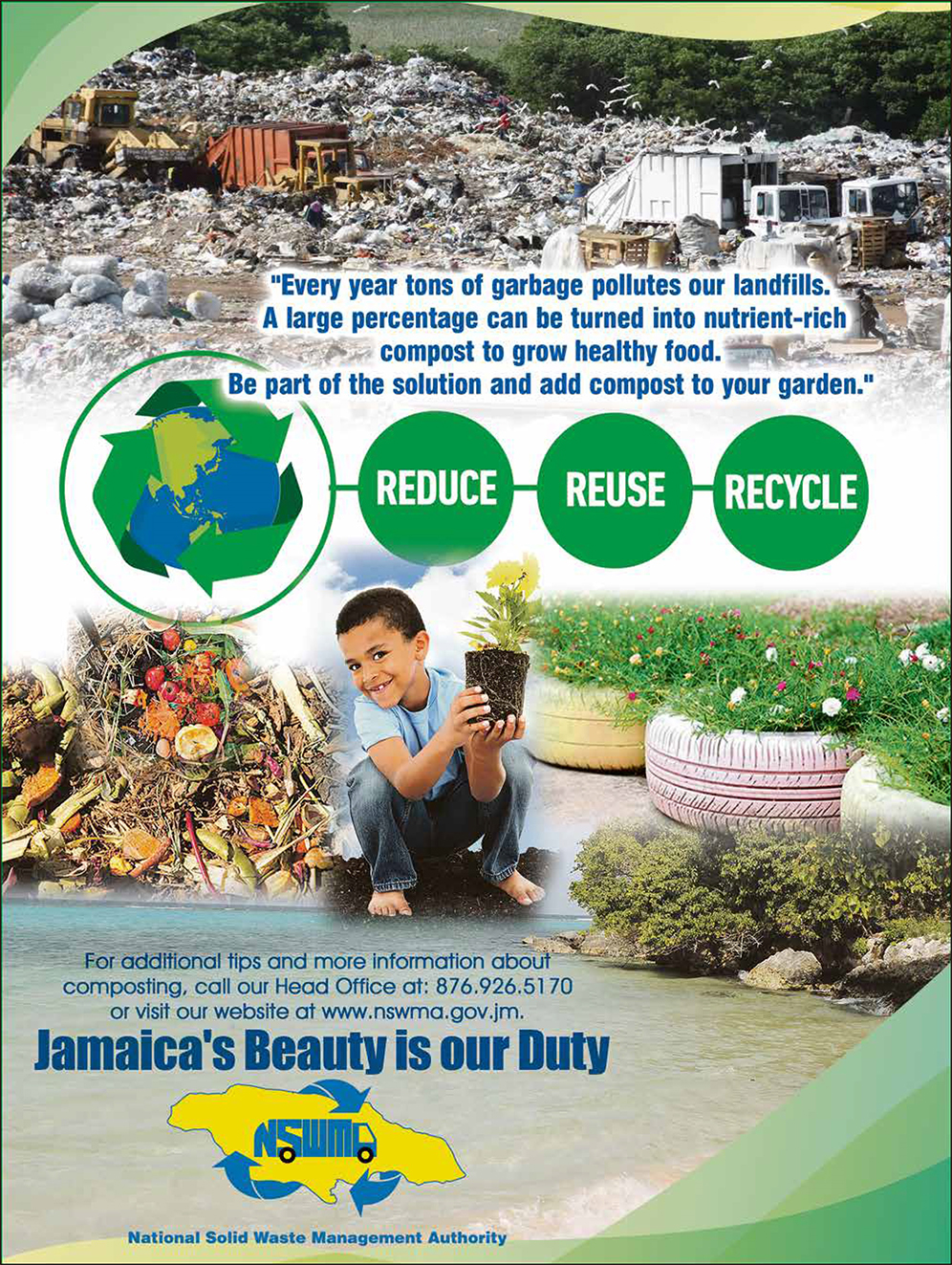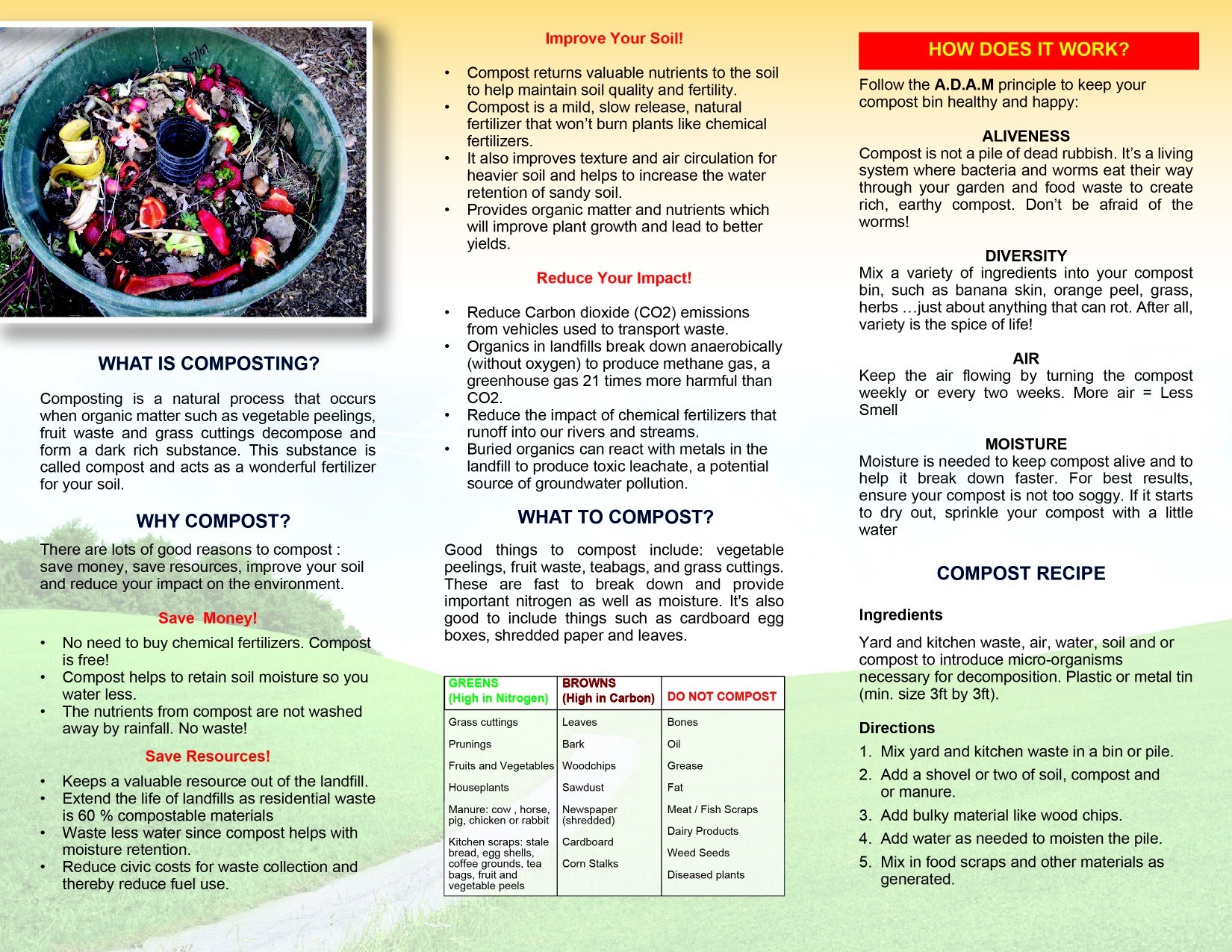Backyard Composting
A Guide for Composting Yard and Food WasteWhat is Composting?
Composting is nature’s process of recycling decomposed organic materials into a rich soil known as compost. Anything that was once living will decompose. Basically, backyard composting is an acceleration of the same process nature uses. By composting your organic waste, you are returning nutrients back into the soil in order for the cycle of life to continue. Finished compost looks like soil–dark brown, crumbly and smells like a forest floor.
What You Can Compost
- Kitchen scraps (vegetable and fruit peelings)
- Garden refuse; grass and hedge clippings, leaves, flowers
- Manure from herbivores (cow, pig, goat etc.)
- Paper, cardboard, saw dust and wood shavings
- Wood ashes


What Not to Compost
- Diseased plants
- Harmful weeds and seeds
- Human and pet excrement
- Meat scraps, fats, grease or oils
- Dairy products
- Dead animals
- Household chemicals
- Non-organic material (plastic, metal, glass)
Why Compost?
- About 60% of our waste is organic in nature . Composting your kitchen and yard trimmings helps divert this waste from disposal sites, waterways and water treatment facilities.
- You will significantly reduce pest problems–and your use of pesticides.
- Healthy plants from healthy soil look better, produce better fruits and have a much greater ability to fight off pests and diseases.
- Adding organic materials to the soil improves moisture retention.
- Adding decomposed organic material to the soil feeds beneficial organisms.
- Compost amends both sandy and clay soils.
- Compost provides a balanced, slow–release source of nutrients that helps the soil hold nutrients long enough for plants to use them.
- Composting saves money–you avoid the cost of buying soil conditioners, bagged manure etc.
- Feeding your plants well will improve your own diet. Plants grown in depleted soils have a reduced nutrient content.
- Home composting is a valuable tool in educating children about nature and the cycle of life.
Compost Recipe
Ingredients
- Yard and kitchen waste, air, water, soil and compost to introduce micro-organisms necessary for decomposition.
- Plastic or metal tin measuring at least 2ft by 3ft with solid sides and holes for drainage 6” apart.
OR
- Homemade bins made of wire, wood or used pellets measuring at least 3ft by 3ft.
Directions
- Mix yard and kitchen scraps in bin or pile.
- Add one (1) shovel or two (2) of soil, compost and or manure.
- Add bulky material (wood chip).
- Add water as needed to moisten the pile so that the compost is loose and airy.
- Mix compost material together.
- Thoroughly turn over compost once per week. This exercise allows for thorough decomposition, prevents overheating and increases the composting process.
- Compost process is complete within five (5) to eight (8) weeks
How does it Work?
Essential Components:
Biodegrades
Micro-organisms (bacteria, fungi, molds, earthworms, insects) eat the organic material you place in your compost pile
Organic Material
Organic material high in nitrogen and carbon feed the micro-organisms living in your compost pile
Air
The micro-organisms in your compost pile need air in order to break down the organic material. By turning your pile with a fork or hoe, you create air passages for the compost to breathe
Moisture
The compost should be damp, similar to that of a wrung sponge. During dry spells the moisture will evaporate and so it will become necessary to add water. Covering your compost will also help in the retention of moisture on hot days.
Time and Temperature
Composting is accelerated in high temperature. Properly constructed compost can retain a temperature of 130◦ to160◦ degrees Fahrenheit which can also destroy weed seeds.
Prepare for Use
- After the allotted time, the material at the bottom of the compost heap would have transformed into dark, rich smelling soil.
- Sift or separate large clumps from the compost heap.
- Mix the sifted soil with garden and typical yard soil
Checks and Balances
| SYMPTOMS | REASON | SOLUTION |
| Compost heap has a bad odor | Compost is too wet Compost is not properly ventilated |
Add coarse, dry material and mix |
| Centre of the heap is dry or white mould appears | Presence of excess coarse woody material Inadequate water |
Chop/shred coarse woody material Add fresh green waste Turnover and moisten all the ingredients |
| Compost heap is damp and has a sweet odor but is not heated | Lack of nitrogen | Add source of nitrogen – fresh grass clippings or fresh manure |
| Compost heap is damp or warm in the middle but dry elsewhere | Compost heap is too small or dry | Add more material to compost heap Mix and moisten new and old material together to create a larger compost heap |
Alternate Ways to Compost
A number of alternate ways to compost exist. It all depends on one’s individual needs and available resources. The following outlines the different ways to reuse household/yard waste:
Mulching
Simply spread leaves and grass clippings around the base of plants a few inches from the stems. Yard trimmings acts first as a mulch to retain moisture and then decompose to enrich the soil.
Heaps/Piles
Combine organic material together in a heap/pile measuring approximately five (5) feet wide and three (3) feet tall. Gradually add material and regularly moisten and turnover pile
Planting Spots
Dig a hole in the ground at least eight inches (8”) deep and add kitchen scraps. Cover the hole and then use as a plant base.

